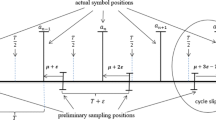Abstract
This paper reviews and presents the simulationresults on the performance of four alternative symboltiming offset estimation algorithms for burst modecommunication. Two basically different approaches are taken to the problem. The first approach isbased on the concept of maximum likelihood estimation,of which two basic varieties are derived and evaluated.These are referred to as the data-driven and the non-data-driven versions. In thedata-driven mode, either the decision symbols from theoutput of the demodulator or a number of known referencesymbols may be used to drive the algorithm. The maximum likelihood algorithms generate an error signalthat can be used in a closed-loop control system toadjust the phase of the sampling clock to the optimumsymbol sampling instant. The second approach uses the basic signal processing technique of tonefiltering using effectively the discrete Fouriertransform. The tone filtering approach results in thedirect estimation of the optimum symbol sampling phase and hence is more of an open-loop approach. Thesimulation results indicate that excellent performanceis achieved with this kind of open-loop approach, evenat low signal to noise ratios and in the presence of some frequency offset as long as the symboltiming offset does not exceed 90% from its optimumpoint. It is also shown that by choosing the propersampling rate, this algorithm results in a simple IIR filtering implementation with one pole that isvery efficient from a processing point ofview.
Similar content being viewed by others
REFERENCES
L. E. Franks, Carrier and bit synchronization in data communica-tion—a tutorial review, IEEE Transactions on Communication, Vol. COM-28, No.8, August 1980.
A. N. D’Andrea, U. Mengali, and M. Morelli, Symbol timing estimation with CPM modulation, IEEE Transactions on Communications, Vol. 44, No.10, October 1996.
M. Moeneclaey and G. de Jonghe, Tracking performance comparison of two ML-oriented carrier-independent DNA symbol synchronizers, IEEE Transactions on Communications, Vol. 40, September 1992.
K. Goethas and M. Moeneclaey, Tracking performance of ML-oriented NDA symbol synchronizers for nonselective fading channels, IEEE Transactions on Communications, Vol. 43, Feb./Mar. /Apr. 1995.
M. Oerder and H. Meyr, Digital filter and square timing recovery, IEEE Transactions on Communications, Vol. COM-36, May 1988.
Bennet, Principles of data communication.
M. Schwartz, Abstract vector spaces applied to problems in detection and estimation theory, IEEE Trans. Inform. Theory, Vol. IT-12, July, pp. 327–336.
G. Ungerboech, Adaptive maximum-likelihood receiver for carrier-modulated data transmission systems, IEEE Transactions on Communications, Vol. COM-22, No.5, May 1974.
D. Efstathiou and A. H. Aghvami, A comparison study of the estimation period of carrier phase and amplitude gain error for 16-ary QAM Rayleigh faded burst transmissions. Proc. Globecom, November 1994.
S. Yoshida, A digital coherent receiver suitable for land-mobile satellite communications, IEEE Transactions on Vehicular Technology, Vol. 44, No.4, November 1995.
M. Rahnema, Coherent detection of non-differentially phase modulated data bursts on Rician fading channels, submitted for publication in IEEE Transactions on Vehicular Technology.
Rights and permissions
About this article
Cite this article
Rahnema, M. Symbol Timing Recovery Algorithms and Their Evaluation for Burst Communication. International Journal of Wireless Information Networks 5, 341–350 (1998). https://doi.org/10.1023/A:1018810828737
Issue Date:
DOI: https://doi.org/10.1023/A:1018810828737




